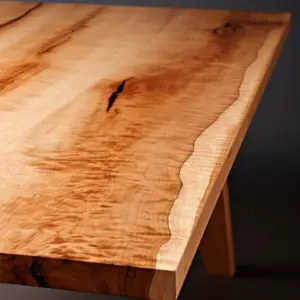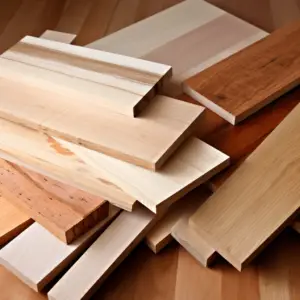Both Maple and Cherry wood are popular types of wood each carrying favor with woodworkers and consumers for different reasons. Both these trees are considered hardwoods but are fairly softer compared to some hardwoods such as hickory and Brazilian teak.
Maple Wood
Although there are dozens of maple tree species globally, maple wood furniture comes from two main trees, Sugar Maple or Acer saccharum and Black Maple or Acer nigrum. These two trees are widely cultivated for timber with Sugar maple being cultivated for the production of maple syrup as well.
Many maple tree species can be harvested and utilized for woodworking but the most sought-after species is the Sugar maple for its hardness and availability.
Cherry Wood

Cherry wood is derived from the cherry tree or cherry trees since there are a number of trees that fall under this category. Of the many varieties of the cherry tree, the most commonly used variety in the lumber sector is the black cherry or Prunus serotina.
It also goes by other names such as mountain black cherry, rum cherry, wild black cherry, and American black cherry. This tree is commonly produced in the eastern parts of the country in amounts large enough to supply lumber but shortages are not uncommon due to the rather specific conditions under which the tree thrives.
This article is a review of sugar maple vs black cherry specifically.
Table of Contents
Maple Vs Cherry Wood
Hardness
Sugar maple wood planks score 1450 on the Janka hardness scale making maple wood one of the best kinds of wood for furniture. This hardness also makes maple wood furniture very long-lasting even with heavy-use furniture such as flooring and beds.
Black cherry wood is comparatively softer with a Janka hardness rating of 950. While this is still a sturdy strong wood, it does not compare to maple wood. It is still sufficient for making furniture and is actually in higher demand compared to the harder maple wood.
Sustainability
Both these species of trees are not listed as endangered which is partly why they are commonly used for lumber. If anything, they are both readily available with sugar maple wood being easier to source than the black cherry.
Black cherry wood can sometimes be more difficult to acquire especially in areas far-flung from the east coast where they thrive. In general, however, sustainability is not a cause for concern at the moment if factors remain constant.
Color and Appearance
Hard maple or sugar maple is one of the few kinds of wood sourced for its sapwood rather than its heartwood. This sapwood has an almost white or off-white color and can have golden hues to it. The heartwood is a darker reddish-brown color. The grain is fairly straight for the most part with sparse knotting.
A freshly sawed plank of the black cherry has a light pink color in the brown heartwood but steadily darkens with exposure to air and sun, gaining a coveted reddish-brown shade. The sapwood is almost light yellow in color. The grain appears evenly placed in straight to wavy lines and has an even texture.
With time, cherry wood darkens and turns a dark reddish hue which is absolutely stunning. This ‘cherry’ color has been used to stain other woods in an attempt to imitate this quality. This quality is also one of the reasons cherry wood is in higher demand compared to hard maple and also accounts for higher pricing.
Cost
Cherry wood is costlier than maple wood mainly because it is harder to source than maple. Moreover, cherry has a higher demand due to its exquisite color countenance and appeal.
The heartwood of the cherry tree is what is used for lumber and a substantial degree of wastage is observed when working with cherry wood since almost no furniture is made using the sapwood.
If any woodworking is done using its sapwood, it is not a popular furniture choice. This could contribute to the pricing even more since a large portion of the tree does not get used.
Maintenance
Both these species are relatively easy to maintain in good condition particularly if they have been treated adequately to provide the necessary protection from UV light, water damage, heat damage, mold, and insect infestation. If left bare, they are not likely to last long so staining and sealing are absolutely necessary.
Every so often, after a few years and depending on how heavy the wear of the furniture is, it would be wise to sand down your furniture pieces and reapply the stain and sealant. With sufficient though infrequent care regimens, both maple and cherry should last decades.
Staining and Painting

The light hues of maple wood are actually very beautiful and painting them is largely unnecessary. That said, maple wood may have light knotting which is visually unattractive for some people. With proper priming, maple wood should take well to painting and even better to staining since it has a fairly even grain texture.
Aside from a light finish, cherry needs no painting or staining and can be treated with a natural stain and sealed. Its natural beauty makes it a moot move to do otherwise.
It would be easy to assume cherry is already painted. With time, the color only gets stronger and the hue more conspicuous so staining it a different shade or painting cherry is a crime.
Workability
Based on their Janka ratings, cherry is a softer wood making it easier to work on with both hand tools and motorized tools. Cherry wood is also very easy to sculpt and engrave making it the obvious choice for woodworking and artisanry.
Maple wood should be fairly easy to work with but its superior hardness makes it more challenging to mold. In rare instances, it may have interlocking grains that make it difficult to work with and smooth out.
With the kinds of modern machines in the industry and ongoing inventions, however, workability should not pose a significant challenge.
Finally…
Maple wood is superior in terms of hardness and durability but cherry wood is the crowd favorite beating maple wood in aesthetic value and workability.
